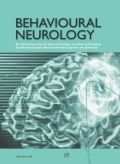Authors: Gardini, Simona | Concari, Letizia | Pagliara, Salvatrice | Ghetti, Caterina | Venneri, Annalena | Caffarra, Paolo
Article Type:
Research Article
Abstract:
This study investigated the cognitive profile and the cerebral perfusion pattern in a highly educated 70 year old gentleman with posterior cortical atrophy (PCA). Visuo-perceptual abilities, spatial memory, spatial representation and navigation, visuo-spatial mental imagery, semantic and episodic-autobiographical memory were assessed. Regional cerebral blood flow (rCBF) was imaged with SPECT. Cognitive testing showed visual-perceptual impairment, apperceptive visual and landmark agnosia, topographical disorientation with way-finding deficits, impaired map learning and poor mental
…image generation. Semantic memory was normal, while episodic-autobiographical memory was impaired. Reduced rCBF was found mainly in the right hemisphere, in the precentral gyrus, posterior cingulate and middle temporal gyri, cuneus and precuneus, in the left superior temporal and lingual gyri and in the parahippocampus bilaterally. Hypoperfusion in occipito-parietal regions was associated with visuo-spatial deficits, whereas deficits in visuo-spatial mental imagery might reflect dysfunction related to hypoperfusion in the parahippocampus and precuneus, structures which are responsible for spatial and imagery processing. Dissociating performance between preserved semantic memory and poor episodic-autobiographical recall is consistent with a pattern of normal perfusion in frontal and anterior temporal regions but abnormal rCBF in the parahippocampi. The present findings indicate that PCA involves visuo-spatial imagery deficits and provide further validation to current neuro-cognitive models of spatial representation and topographical disorientation.
Show more
Keywords: Posterior cortical atrophy, imagery, spatial abilities, visual process, dementia, rCBF
DOI: 10.3233/BEN-2011-0279
Citation: Behavioural Neurology,
vol. 24, no. 2, pp. 123-132, 2011
Price: EUR 27.50





